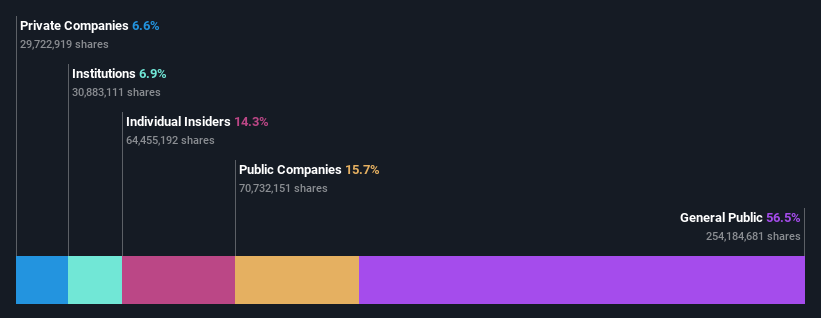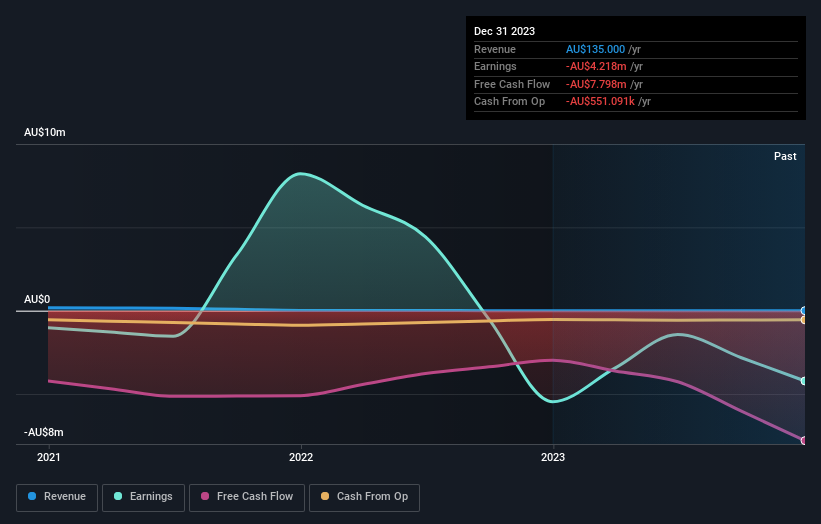- Australia
- /
- Metals and Mining
- /
- ASX:ENR
Encounter Resources Limited's (ASX:ENR) market cap surged AU$38m last week, retail investors who have a lot riding on the company were rewarded

Key Insights
- Significant control over Encounter Resources by retail investors implies that the general public has more power to influence management and governance-related decisions
- The top 19 shareholders own 44% of the company
- Insiders have bought recently
To get a sense of who is truly in control of Encounter Resources Limited (ASX:ENR), it is important to understand the ownership structure of the business. And the group that holds the biggest piece of the pie are retail investors with 56% ownership. Put another way, the group faces the maximum upside potential (or downside risk).
Clearly, retail investors benefitted the most after the company's market cap rose by AU$38m last week.
Let's take a closer look to see what the different types of shareholders can tell us about Encounter Resources.
Check out our latest analysis for Encounter Resources

What Does The Institutional Ownership Tell Us About Encounter Resources?
Many institutions measure their performance against an index that approximates the local market. So they usually pay more attention to companies that are included in major indices.
As you can see, institutional investors have a fair amount of stake in Encounter Resources. This can indicate that the company has a certain degree of credibility in the investment community. However, it is best to be wary of relying on the supposed validation that comes with institutional investors. They too, get it wrong sometimes. It is not uncommon to see a big share price drop if two large institutional investors try to sell out of a stock at the same time. So it is worth checking the past earnings trajectory of Encounter Resources, (below). Of course, keep in mind that there are other factors to consider, too.

We note that hedge funds don't have a meaningful investment in Encounter Resources. The company's largest shareholder is IGO Limited, with ownership of 6.3%. With 6.2% and 6.1% of the shares outstanding respectively, William Robinson and Chalice Mining Limited are the second and third largest shareholders. William Robinson, who is the second-largest shareholder, also happens to hold the title of Top Key Executive.
On studying our ownership data, we found that 19 of the top shareholders collectively own less than 50% of the share register, implying that no single individual has a majority interest.
While it makes sense to study institutional ownership data for a company, it also makes sense to study analyst sentiments to know which way the wind is blowing. As far as we can tell there isn't analyst coverage of the company, so it is probably flying under the radar.
Insider Ownership Of Encounter Resources
While the precise definition of an insider can be subjective, almost everyone considers board members to be insiders. The company management answer to the board and the latter should represent the interests of shareholders. Notably, sometimes top-level managers are on the board themselves.
Most consider insider ownership a positive because it can indicate the board is well aligned with other shareholders. However, on some occasions too much power is concentrated within this group.
Our most recent data indicates that insiders own a reasonable proportion of Encounter Resources Limited. Insiders own AU$27m worth of shares in the AU$189m company. We would say this shows alignment with shareholders, but it is worth noting that the company is still quite small; some insiders may have founded the business. You can click here to see if those insiders have been buying or selling.
General Public Ownership
The general public -- including retail investors -- own 56% of Encounter Resources. This level of ownership gives investors from the wider public some power to sway key policy decisions such as board composition, executive compensation, and the dividend payout ratio.
Private Company Ownership
It seems that Private Companies own 6.6%, of the Encounter Resources stock. It might be worth looking deeper into this. If related parties, such as insiders, have an interest in one of these private companies, that should be disclosed in the annual report. Private companies may also have a strategic interest in the company.
Public Company Ownership
It appears to us that public companies own 16% of Encounter Resources. This may be a strategic interest and the two companies may have related business interests. It could be that they have de-merged. This holding is probably worth investigating further.
Next Steps:
While it is well worth considering the different groups that own a company, there are other factors that are even more important. To that end, you should learn about the 2 warning signs we've spotted with Encounter Resources (including 1 which is a bit concerning) .
If you would prefer check out another company -- one with potentially superior financials -- then do not miss this free list of interesting companies, backed by strong financial data.
NB: Figures in this article are calculated using data from the last twelve months, which refer to the 12-month period ending on the last date of the month the financial statement is dated. This may not be consistent with full year annual report figures.
Valuation is complex, but we're here to simplify it.
Discover if Encounter Resources might be undervalued or overvalued with our detailed analysis, featuring fair value estimates, potential risks, dividends, insider trades, and its financial condition.
Access Free AnalysisHave feedback on this article? Concerned about the content? Get in touch with us directly. Alternatively, email editorial-team (at) simplywallst.com.
This article by Simply Wall St is general in nature. We provide commentary based on historical data and analyst forecasts only using an unbiased methodology and our articles are not intended to be financial advice. It does not constitute a recommendation to buy or sell any stock, and does not take account of your objectives, or your financial situation. We aim to bring you long-term focused analysis driven by fundamental data. Note that our analysis may not factor in the latest price-sensitive company announcements or qualitative material. Simply Wall St has no position in any stocks mentioned.
About ASX:ENR
Encounter Resources
Engages in the mineral exploration, and project generation and development activities in Australia.
Flawless balance sheet slight.


